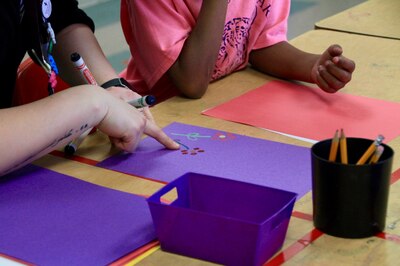How do teachers captivate their students? Here, in a feature we call How I Teach, we ask great educators how they approach their jobs. You can see other pieces in this series here.
When Anna Barton Schnadelbach asked her art students to draw something to make the world a more beautiful place, one student asked for help to draw flowers.
“You’re an artist,” he told Barton Schnadelbach as she outlined flowers in crayon.
“We’re all artists!” shouted a few of his classmates.
It’s a familiar mantra from Barton Schnadelbach, who teaches visual art at Memphis Scholars Caldwell-Guthrie Elementary School. She has even shown her students her own scribbles as a 5-year-old to help them visualize their teacher when she was their age.

We asked her a to explain more about her teaching style and how she incorporates life lessons into art class in this installment of How I Teach:
Why did you become a teacher?
After working in the legal field for a decade, I decided to go back to school for a master’s in art therapy. While taking undergraduate prerequisite art courses, I met an amazing professor. Her work and course were incredible, but some of my younger classmates struggled with her instruction. I was 30-something taking a freshman- level course with 18- and 19-year olds. I would break down the instruction in ways that were more digestible. My professor noticed this and told me I would make a great teacher. Something in that moment just clicked. A few weeks later I was changing my degree from art therapy to art education.
What is one of your favorite lessons to teach? How did you come up with the idea?
It’s basic, but I love teaching color mixing with a primary color scheme. There is a spark ignited when a child experiences self-discovery. The sheer amazement that comes with creating “new” color is one of the most joyous expressions I have ever seen.
So many times I hear, “I can’t” or “it’s too hard.” But this [lesson] is fail-proof. Any combination produces something new and interesting.
How do you respond when a student doesn’t understand your lesson?

I break everything down to basics. When a student says I can’t draw this or that, we study the object together and look for the basic lines and shapes. I emphasize daily that I’m only looking for your personal best. If all my students came in as perfect artists, I’d be out of a job.
How do you get your class’s attention if students are talking or off task?
For K-2, I say “1-2-3, all artists freeze, hands on your head, bubble in your mouth.”
For 3-5, I use “Yo? Yo? Yo! And they respond Yo! What’s up?”
How do you get to know your students and build relationships with them? What questions do you ask or what actions do you take?
I always begin by telling them about me. I show them my struggles with art. I allow them to see me as a person. I have a bulletin board that I put up at the beginning of the year. It has work dating back to pre-K, along with photographs of me throughout the years.
As a child, it’s hard to remember that your teacher was once a child too. Sharing my 5-year-old scribbles and bad middle school bangs makes me a little more approachable.

Tell us about a memorable time — good or bad — when contact with a student’s family changed your perspective or approach.
I think the most memorable moments are ones like the time a student introduced me to her mother, “Momma, this is Ms. Barton, she’s my school mama. Ms. Barton, this my momma.”
Knowing a child is hungry, they’ve lost a loved one, someone is in jail, the heat is out; these things influence my perspective and approach.
I couldn’t teach without my:
Imagination. I have worked in situations where supplies were scarce and resources few, but as long as I have my imagination, I can make a lesson work.
What’s the best advice you ever received?
Every day is a clean slate. Don’t hold grudges. Even with my most trying children, I have to start every day fresh, with a new dose of patience.



